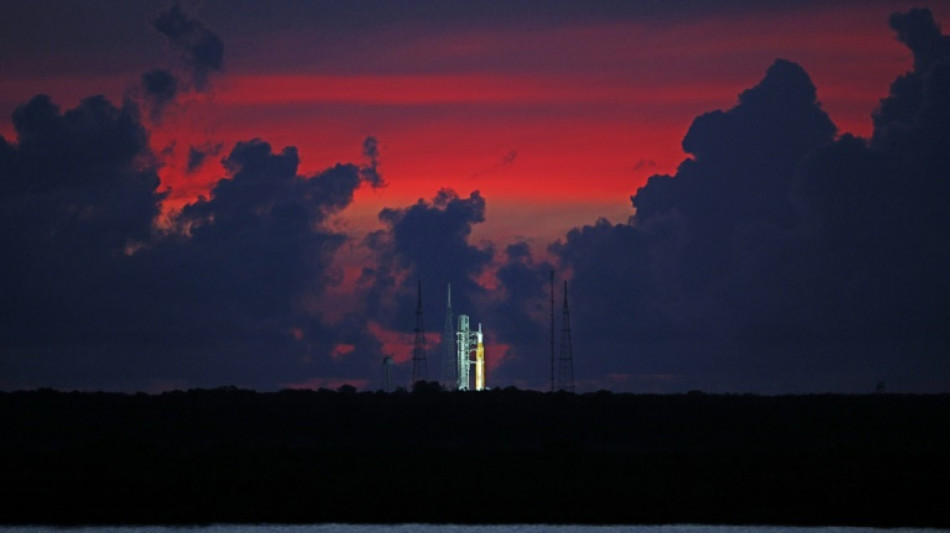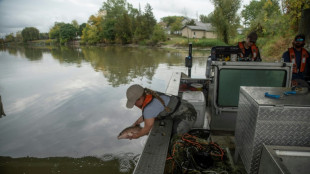
-
 Italy working hard to prevent extra US tariffs on pasta
Italy working hard to prevent extra US tariffs on pasta
-
Sinner out of Shanghai Masters as Djokovic battles into last 16

-
 Swift rules N. America box office with 'Showgirl' event
Swift rules N. America box office with 'Showgirl' event
-
Ryder Cup hero MacIntyre wins Alfred Dunhill Links on home soil

-
 Republicans warn of pain ahead as US shutdown faces second week
Republicans warn of pain ahead as US shutdown faces second week
-
Sevilla rout champions Barca in shock Liga thrashing

-
 Norris-Piastri clash overshadows McLaren constructors' title win
Norris-Piastri clash overshadows McLaren constructors' title win
-
Trump administration declares US cities war zones

-
 Bad Bunny takes aim at Super Bowl backlash in 'SNL' host gig
Bad Bunny takes aim at Super Bowl backlash in 'SNL' host gig
-
El Khannouss fires Stuttgart into Bundesliga top four

-
 Insatiable Pogacar romps to European title
Insatiable Pogacar romps to European title
-
Newcastle inflict more pain on Postecoglou, Everton end Palace's unbeaten run

-
 Daryz wins Prix de l'Arc de Triomphe thriller
Daryz wins Prix de l'Arc de Triomphe thriller
-
Russell wins Singapore GP as McLaren seal constructors' title

-
 Landslides and floods kill 64 in Nepal, India
Landslides and floods kill 64 in Nepal, India
-
Russell wins Singapore GP, McLaren seal constructors' title

-
 Djokovic 'hangs by rope' before battling into Shanghai last 16
Djokovic 'hangs by rope' before battling into Shanghai last 16
-
Erasmus proud of Boks' title triumph as Rugby Championship faces uncertain future

-
 French PM under pressure to put together cabinet
French PM under pressure to put together cabinet
-
US Open finalist Anisimova beats Noskova to win Beijing title

-
 Hamas calls for swift hostage-prisoner swap as talks set to begin
Hamas calls for swift hostage-prisoner swap as talks set to begin
-
Opec+ plus to raise oil production by 137,000 barrels a day in November

-
 Death toll from Indonesia school collapse rises to 45
Death toll from Indonesia school collapse rises to 45
-
Brisbane Broncos edge Storm in thrilling NRL grand final

-
 Refreshed Sabalenka 'ready to go' after post-US Open break
Refreshed Sabalenka 'ready to go' after post-US Open break
-
Georgia PM vows sweeping crackdown after 'foiled coup'

-
 Landslides and floods kill 63 in Nepal, India
Landslides and floods kill 63 in Nepal, India
-
No handshakes again as India, Pakistan meet at Women's World Cup

-
 Georgia PM announces sweeping crackdown on opposition after 'foiled coup'
Georgia PM announces sweeping crackdown on opposition after 'foiled coup'
-
Syria selects members of first post-Assad parliament

-
 Russian strikes kill five in Ukraine, cause power outages
Russian strikes kill five in Ukraine, cause power outages
-
World champion Marquez crashes out of Indonesia MotoGP

-
 Babis to meet Czech president after party tops parliamentary vote
Babis to meet Czech president after party tops parliamentary vote
-
Death toll from Indonesia school collapse rises to 37

-
 OPEC+ meets with future oil production hanging in the balance
OPEC+ meets with future oil production hanging in the balance
-
Dodgers down Phillies on Hernandez homer in MLB playoff series opener

-
 Philadelphia down NYCFC to clinch MLS Supporters Shield
Philadelphia down NYCFC to clinch MLS Supporters Shield
-
Syria selects members of first post-Assad parliament in contested process

-
 Americans, Canadians unite in battling 'eating machine' carp
Americans, Canadians unite in battling 'eating machine' carp
-
Negotiators due in Cairo for Gaza ceasefire, hostage release talks

-
 Trump authorizes troops to Chicago as judge blocks Portland deployment
Trump authorizes troops to Chicago as judge blocks Portland deployment
-
Wallabies left ruing missed chances ahead of European tour

-
 Higgo stretches PGA Tour lead in Mississippi
Higgo stretches PGA Tour lead in Mississippi
-
Blue Jays pummel Yankees 10-1 in MLB playoff series opener

-
 Georgia ruling party wins local polls as mass protests flare
Georgia ruling party wins local polls as mass protests flare
-
Depoortere stakes France claim as Bordeaux-Begles stumble past Lyon

-
 Vinicius double helps Real Madrid beat Villarreal
Vinicius double helps Real Madrid beat Villarreal
-
New museum examines family life of Mexican artist Frida Kahlo

-
 Piccioli sets new Balenciaga beat, with support from Meghan Markle
Piccioli sets new Balenciaga beat, with support from Meghan Markle
-
Lammens must be ready for 'massive' Man Utd scrutiny, says Amorim


All systems go for Artemis 1 mission to Moon
Fifty years after the last Apollo mission, the Artemis program is poised to take up the baton of lunar exploration with a test launch on Monday of NASA's most powerful rocket ever.
The goal is to return humans to the Moon for the first time since the last Apollo mission in 1972 -- and eventually to Mars.
The 322-foot (98-meter) Space Launch System (SLS) rocket is scheduled to blast off at 8:33 am (1233 GMT) from the Kennedy Space Center (KSC) in Florida.
The mission, more than a decade in the planning, may be uncrewed, but is highly symbolic for NASA, which has been under pressure from China and private rivals such as SpaceX.
Hotels around Cape Canaveral are booked solid with between 100,000 and 200,000 spectators expected to attend the launch.
The massive orange-and-white rocket has been sitting on KSC's Launch Complex 39B for a week.
"Ever since we rolled out to the pad last week, you can feel the excitement, the energy," said Janet Petro, director of KSC. "It's really, really palpable."
The objective of the flight, baptized Artemis 1, is to test the SLS and the Orion crew capsule that sits atop the rocket.
Mannequins equipped with sensors will take the place of crew members, recording acceleration, vibration and radiation levels.
Cameras will capture every moment of the 42-day trip and include a selfie of the spacecraft with the Moon and Earth in the background.
- Splashdown in Pacific -
The Orion capsule will orbit around the Moon, coming within 60 miles (100 kilometers) at its closest approach and then firing its engines to get to a distance 40,000 miles beyond, a record for a spacecraft rated to carry humans.
One of the primary objectives of the mission is to test the capsule's heat shield, which at 16 feet in diameter is the largest ever built.
On its return to the Earth's atmosphere, the heat shield will have to withstand a speed of 25,000 miles per hour and a temperature of 5,000 degrees Fahrenheit (2,760 degrees Celsius).
Orion, its descent slowed by parachutes, will end its voyage with a splashdown off the coast of San Diego in the Pacific.
Monday's liftoff will be at the mercy of the weather, which can be unpredictable in Florida at this time of year, and NASA has built in a two-hour launch window.
If the rocket is unable to take off on Monday, September 2 and 5 have been penciled in as alternative flight dates.
Otherwise, it's all systems go.
NASA gave the green light for the mission on Tuesday after a detailed inspection known as a flight readiness review.
That doesn't mean things can't go wrong with a rocket and a capsule flying for the first time.
- 'Inherent risk' -
"We're doing something that is incredibly difficult to do and does carry inherent risk in it," said Mike Sarafin, the Artemis 1 mission manager.
Because it is an uncrewed flight, Sarafin said the mission will continue in conditions that would not be acceptable for a flight with astronauts.
"If we had a failed solar array deployment we would proceed, and that is something that we wouldn't necessarily do on a crewed flight," he said.
A complete failure would be devastating for a program that is costing $4.1 billion per launch and is already running years behind schedule.
The next mission, Artemis 2, will take astronauts into orbit around the Moon without landing on its surface. The crew of Artemis 3 is to land on the Moon in 2025 at the earliest.
While the Apollo astronauts who walked on the Moon were exclusively white men, the Artemis program plans to include the first woman and person of color.
And since humans have already visited the Moon, Artemis has its sights set on another lofty goal -- an eventual crewed mission to Mars.
Gateway would serve as a staging and refueling station for a voyage to Mars that would take a minimum of several months.
"I think it's going to inspire even more than Apollo did," Bob Cabana, associate NASA administrator and a former astronaut, said of Artemis. "It's going to be absolutely outstanding."
G.Schulte--BTB




